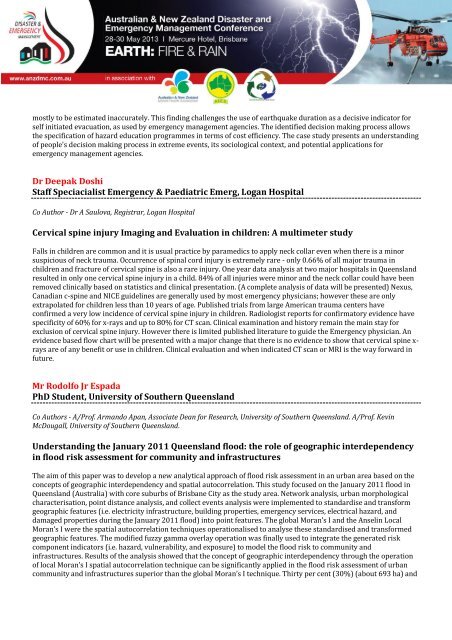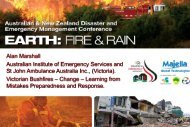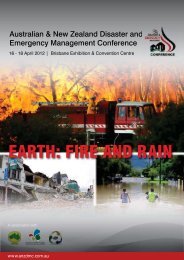Book of Abstracts 2013 - Australian and New Zealand Disaster ...
Book of Abstracts 2013 - Australian and New Zealand Disaster ...
Book of Abstracts 2013 - Australian and New Zealand Disaster ...
Create successful ePaper yourself
Turn your PDF publications into a flip-book with our unique Google optimized e-Paper software.
mostly to be estimated inaccurately. This finding challenges the use <strong>of</strong> earthquake duration as a decisive indicator for<br />
self initiated evacuation, as used by emergency management agencies. The identified decision making process allows<br />
the specification <strong>of</strong> hazard education programmes in terms <strong>of</strong> cost efficiency. The case study presents an underst<strong>and</strong>ing<br />
<strong>of</strong> people's decision making process in extreme events, its sociological context, <strong>and</strong> potential applications for<br />
emergency management agencies.<br />
Dr Deepak Doshi<br />
Staff Speciacialist Emergency & Paediatric Emerg, Logan Hospital<br />
Co Author - Dr A Saulova, Registrar, Logan Hospital<br />
Cervical spine injury Imaging <strong>and</strong> Evaluation in children: A multimeter study<br />
Falls in children are common <strong>and</strong> it is usual practice by paramedics to apply neck collar even when there is a minor<br />
suspicious <strong>of</strong> neck trauma. Occurrence <strong>of</strong> spinal cord injury is extremely rare - only 0.66% <strong>of</strong> all major trauma in<br />
children <strong>and</strong> fracture <strong>of</strong> cervical spine is also a rare injury. One year data analysis at two major hospitals in Queensl<strong>and</strong><br />
resulted in only one cervical spine injury in a child. 84% <strong>of</strong> all injuries were minor <strong>and</strong> the neck collar could have been<br />
removed clinically based on statistics <strong>and</strong> clinical presentation. (A complete analysis <strong>of</strong> data will be presented) Nexus,<br />
Canadian c-spine <strong>and</strong> NICE guidelines are generally used by most emergency physicians; however these are only<br />
extrapolated for children less than 10 years <strong>of</strong> age. Published trials from large American trauma centers have<br />
confirmed a very low incidence <strong>of</strong> cervical spine injury in children. Radiologist reports for confirmatory evidence have<br />
specificity <strong>of</strong> 60% for x-rays <strong>and</strong> up to 80% for CT scan. Clinical examination <strong>and</strong> history remain the main stay for<br />
exclusion <strong>of</strong> cervical spine injury. However there is limited published literature to guide the Emergency physician. An<br />
evidence based flow chart will be presented with a major change that there is no evidence to show that cervical spine x-<br />
rays are <strong>of</strong> any benefit or use in children. Clinical evaluation <strong>and</strong> when indicated CT scan or MRI is the way forward in<br />
future.<br />
Mr Rodolfo Jr Espada<br />
PhD Student, University <strong>of</strong> Southern Queensl<strong>and</strong><br />
Co Authors - A/Pr<strong>of</strong>. Arm<strong>and</strong>o Apan, Associate Dean for Research, University <strong>of</strong> Southern Queensl<strong>and</strong>. A/Pr<strong>of</strong>. Kevin<br />
McDougall, University <strong>of</strong> Southern Queensl<strong>and</strong>.<br />
Underst<strong>and</strong>ing the January 2011 Queensl<strong>and</strong> flood: the role <strong>of</strong> geographic interdependency<br />
in flood risk assessment for community <strong>and</strong> infrastructures<br />
The aim <strong>of</strong> this paper was to develop a new analytical approach <strong>of</strong> flood risk assessment in an urban area based on the<br />
concepts <strong>of</strong> geographic interdependency <strong>and</strong> spatial autocorrelation. This study focused on the January 2011 flood in<br />
Queensl<strong>and</strong> (Australia) with core suburbs <strong>of</strong> Brisbane City as the study area. Network analysis, urban morphological<br />
characterisation, point distance analysis, <strong>and</strong> collect events analysis were implemented to st<strong>and</strong>ardise <strong>and</strong> transform<br />
geographic features (i.e. electricity infrastructure, building properties, emergency services, electrical hazard, <strong>and</strong><br />
damaged properties during the January 2011 flood) into point features. The global Moran’s I <strong>and</strong> the Anselin Local<br />
Moran’s I were the spatial autocorrelation techniques operationalised to analyse these st<strong>and</strong>ardised <strong>and</strong> transformed<br />
geographic features. The modified fuzzy gamma overlay operation was finally used to integrate the generated risk<br />
component indicators (i.e. hazard, vulnerability, <strong>and</strong> exposure) to model the flood risk to community <strong>and</strong><br />
infrastructures. Results <strong>of</strong> the analysis showed that the concept <strong>of</strong> geographic interdependency through the operation<br />
<strong>of</strong> local Moran’s I spatial autocorrelation technique can be significantly applied in the flood risk assessment <strong>of</strong> urban<br />
community <strong>and</strong> infrastructures superior than the global Moran’s I technique. Thirty per cent (30%) (about 693 ha) <strong>and</strong>






